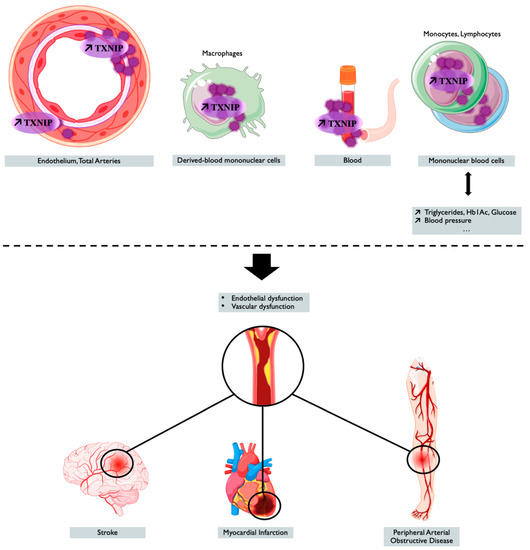Thioredoxin interacting protein (TXNIP) is a metabolism- oxidative- and inflammation-related marker induced in cardiovascular diseases and is believed to represent a possible link between metabolism and cellular redox status. TXNIP is a potential biomarker in cardiovascular and ischemic diseases but also a novel identified target for preventive and curative medicine.
- TXNIP
- cardiovascular diseases marker
1. Introduction
Cardiovascular diseases remain a major cause of death worldwide and are increasing due to the ageing population and poor eating habits. The pathological changes are originally characterized by metabolic disorders and endothelial dysfunction. Oxidative stress plays an important role and induces vascular-related gene expression, promoting local inflammatory response and cell life and death dysregulation. When oxidative stress occurs, vascular walls produce excessive reactive oxygen species (ROS), which causes damage to the structure and function of endothelial cells. That enhances the inflammatory response of the vascular wall and impairs vascular function or revascularization. ROS are produced continuously during cell metabolism and are used as mediators in many biological processes. Specifically, ROS reversibly activate signaling pathways that trigger adaptation systems in the cell. Previous works have associated excessive ROS with age-related pathologies [1,2,3,4,5,6,7]. However, recent reviews still report that excessive ROS can lead to diseases and pathological conditions [8,9,10,11]. Thioredoxin interacting protein (TXNIP) is a metabolism- oxidative- and inflammation-related marker induced in cardiovascular pathologies and could represent an emergent link between physiopathology and cardiovascular events. More precisely, TXNIP has been widely described as a pro-oxidant compound [12,13], but it is also a regulator of metabolism [14,15,16,17], a modulator of the inflammatory [18,19] or angiogenic response [20,21], and an antiproliferative and pro-apoptotic agent [22,23]. Clinically, genetic association studies have shown that polymorphisms affecting TXNIP expression are linked to hypertension and arterial stiffness and increase the risk of coronary heart disease [24,25,26]. Epigenetic modifications of TXNIP are also associated with risks of cardiovascular diseases [27,28]. Additionally, blood or mononuclear blood cells’ mRNA TXNIP levels have been related to coronary and heart diseases [29,30,31].
2. TXNIP is a Multifunctional Protein
| Function | Signalling Partner | References |
|---|---|---|
| Shuttle | TRX | [36,37] |
| HIF1a | [38] | |
| NfkB | [39,40] | |
| Itch | [41,42,43] | |
| Prooxydant | TRX | [13,21,32,40,44,45,46,47,48,49,50,51,52,53,54,55] |
| NADPH oxidase | [13,21,51,52,56,57,58] | |
| AMPK/NrF2 | [59,60,61,62] | |
| Redd1 | [63,64] | |
| Proinflammatory | NLRP3 | [13,18,21,60,65,66,67,68,69,70,71,72,73,74,75,76,77,78,79,80,81,82,83,84,85,86,87,88,89,90,91,92,93,94,95,96,97,98,99,100,101,102,103,104,105] |
| AMPK/NrF2 | [60,62,90,92,102,103,104,106,107,108] | |
| NF-κB | [39,40,72,83,109,110] | |
| Kruppel-like factor 2 | [111] | |
| Metabolism | AMPK | [92,112,113] |
| MondoA | [114,115] | |
| IGF1 | [116] | |
| Glut1 | [33,113,117,118,119] | |
| Glut4 | [120] | |
| ChREBP/FOXO1 | [121] | |
| Target of miRNA | miR-17, miR-17-5p | [122,123,124,125] |
| miR-20a, miR-20b | [126] | |
| miR-25-5p | [127] | |
| miR-30c-5p | [128] | |
| miR-33 | [129] | |
| miR-146a | [130] | |
| miR-370 | [131] | |
| miR-497 | [132] |
3. TXNIP is a Novel Marker in Cardiovascular Diseases
TXNIP is a genetic, blood, peripheral blood cells, and tissue ischemia marker associated with cardiovascular diseases, as summarized in Figure 2 and in Table 2, thus making TXNIP an interesting target for prognostic and treatment.

Table 2. TXNIP as a marker of cardiovascular risk and disease.
| Location | Parameter or Disease | References | |
|---|---|---|---|
| Genetic Marker | TXNIP rs7211 variant | Arterial stiffness, obesity | [24,151] |
| TXNIP rs7211- rs7212 variants | Glucose, blood pressure, coronary atherosclerosis | [24,26] | |
| Various epigenetic changes | T2D | [188,189] | |
| DNA methylation cg19693031 | Blood pressure, T2D, coronary artery disease | [26,27,28,190,191,192,193,194,195,196,197] | |
| Triglycerides and/or HbA1C levels | [27,190,191,192,193,198] | ||
| Blood Marker | Plasma or serum levels of TXNIP | Carotid Intima Media Thickness | [30] |
| Stroke or heart attack | [55,199] | ||
| Diabetes associated macrovascular endothelial dysfunction | [17] | ||
| Diabetes associated vascular complications | [19] | ||
| mRNA Marker | TXNIP in peripheral blood cells | At-risk Takayasu arteritis, atherosclerosis, coronary artery disease, leukostasis | [80,94,110,200,201,202,203] |
| Unstable angina pectoris, acute myocardial infarction | [29,204] | ||
| Diabetes associated macrovascular endothelial dysfunction | [17] | ||
| Diabetes associated vascular complications | [19,205] | ||
| TXNIP in cardiac tissue | Heart attack | [55] | |
| TXNIP in aortic tissue | At-risk Takayasu arteritis, atherosclerosis, arterial aging | [51,200,202,206] | |
| Diabetes associated macrovascular endothelial dysfunction | [17] | ||
| Diabetes associated vascular complications | [19] | ||
| Tissue Marker | TXNIP in bonne marrow | Mobilization of cells | [202] |
| TXNIP in Myocardiac ischemia | I/R damage (infarct size or ventricular remodeling or heart failure or atrial fibrillation) | [207,208] | |
| I/R damage in diabetic hearts or survival | [64,100,109,209,210,211,212,213,214] | ||
| TXNIP in Hind limb ischemia | Reperfusion of ischemic limb, tissue-recovery, capillary density in diabetic mouse | [173,215,216] | |
| Reperfusion of ischemic limb, tissue-recovery, capillary density in mouse with fat diet | [217,218] | ||
| TXNIP in cerebral ischemia | Ischemic stroke | [58,60,61,102,103,108,127,219,220,221,222,223,224,225,226,227] | |
| Subarachnoid haemorrhage | [62,228,229,230] | ||
| Neonatal hypoxic-ischemia | [124,125,231] | ||
| Vascular dementia | [232] |
This entry is adapted from the peer-reviewed paper 10.3390/ijms22041693
